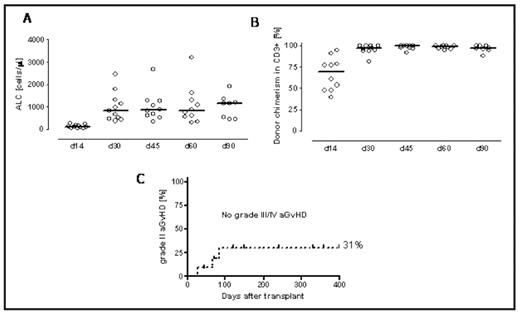Abstract
Patients undergoing allogeneic cell transplantation (HCT), who develop chronic Graft versus Host Disease (GVHD), can show a cutaneous involvement similar to that of patients with systemic sclerosis (SSc). Human Cytomegalovirus (hCMV) has been shown to be implicated in the pathogenesis of SSc, since a subset of anti-hCMV antibodies directed against the late viral protein UL94, cross-react with the cell surface tetraspanin NAG-2, and induce the vascular and fibrotic damage observed in the disease. HCMV infection and/or its reactivation have also been associated with the increased risk to develop GVHD and with the worsening of clinical manifestations. Immunosuppressive treatment for GVHD can be intuitively correlated to the viral reactivation, however, the pathogenetic link between hCMV infection and chronic GVHD is still lacking. In this study we wanted first to evaluate the presence of anti-hCMV antibodies directed against the viral protein UL94 in the plasma of HCT patients and second to study their possible role in the pathogenesis of chronic GVHD. Eighteen patients undergone allogeneic HCT for hematological malignancies (16 with nonmyeloablative conditioning regimen and 2 with myeloablative), between 2003 and 2006, with a median follow-up of 7.35 months (range 1.2–55.7), were retrospectively studied. Five of them were anti-hCMV antibodies negative but their donors were anti-hCMV IgG positive. Twelve patients experienced hCMV reactivation evaluated by pp65 and PCR and they needed either Gancyclovir or Valgancyclovir or Foscavir as preemptive therapy. Interestingly, almost all patients (11/12) with hCMV reactivation developed chronic GVHD, and six of the eleven had acute GVHD. All GVHD patients showed skin involvement, and some of them had evidence of diffuse skin fibrosis remarkably similar to that of SSc. None of the patients nor of the donors were suffering from autoimmune diseases. Five of 18 are still alive and in complete remission, included the 2 patients with a skin involvement similar to diffuse SSc. One patient with diffuse skin involvement was lost to the follow-up. Thirteen patients died: 8 for progression of disease, 4 because of steroid resistant GVHD, 1 for sepsis and multi-organ failure. Patients who died before day 100 were not suitable for chronic GVHD evaluation. Patients who developed chronic GVHD showed the presence of anti-hCMV derived late viral protein UL94. Remarkably, the 3 patients with chronic GVHD who developed a diffuse SSc-like skin involvement, had antibodies directed against NAG-2, a cell surface tetraspanin that forms complexes with integrins, already reported to play a pivotal role in the pathogenesis of SSc. Such antibodies bound endothelial cells and fibroblasts and were able to induce endothelial cell apoptosis and fibroblast proliferation, as already shown in patients with SSc (Methods as previously published by Lunardi C. et al. on Nat Med. 2000 Oct; 6(10):1183–6 and PLoS Med. 2006 Jan; 3(1 e 2): 94–108). These findings sustain the involvement of hCMV infection in the pathogenesis of chronic skin GVHD through a mechanism of molecular mimicry between the viral late protein UL94 and the cell surface molecule NAG-2. Moreover, these data provide a previously unknown pathogenetic mechanism by which hCMV infection contributes to the development of chronic skin GVHD resembling SSc. Perspective studies with a larger number of patients are needed to further support these results.
Disclosures: No relevant conflicts of interest to declare.
Author notes
Corresponding author


